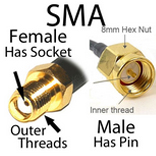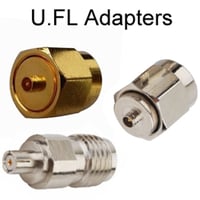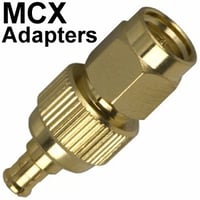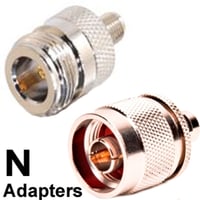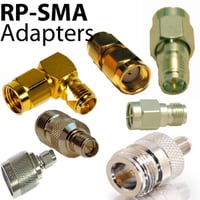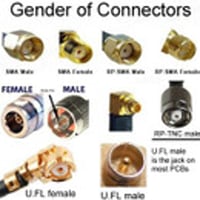Combo Antennas: LTE/4G, WiFi, GPS, 3G / GSM
Combination Antennas:
Combo Antennas have more than one antenna inside their radome (housing).
- By "Combination Antenna" or "Combo Antenna" we are not referring to "dual band." Data Alliance carries many dual-band WiFi antennas and dual-band LTE antennas, that have their own subcategories on our site and are not included in this category of "combo antennas."
- All of our GPS/LTE combination antennas can be customized with passive GPS.
- Most of our combo antennas are "puck style."
LTE GPS Combo Antenna is a desirable set up for professionals such as emergency workers or field operatives who need high quality connectivity with mobility and offers the benefits and use of both 4G and GPS technologies. Combination antennas integrated in a single unit save on costs, are easier to install and have a more pleasing appearance.
LTE-AUX Antenna-Cable Connection: Purpose
Some of our LTE / 4G (Long Term Evolution) antennas are equipped with two coaxial cables with antenna connectors:
- LTE-main and
- LTE-AUX
These cable connections are provided in order to achieve an optimal LTE set up and performance.
LTE uses a wireless technology called MiMo. MiMo stands for multiple input, multiple output and utilizes multiple antennas which transmit and receive cellular signals. For this technology to perform optimally with high data rates a minimum of 2 antennas are required. Connecting both LTE-main and LTE-aux cable from the main to a second antenna will massively improve both the reception and throughput of 4G LTE. A dual antenna setup utilizing both cables and connections optimizes connection stability by using multiple radio paths to create spatial diversity as well as absorbing any cellular interference. The main antenna both transmits and receives data and the auxiliary is a receiving antenna. In addition, a GPS antenna can be alternatively connected to the auxiliary input to create an LTE / GPS combo antenna set up.
Puck Antennas with Through-Hole Mounting
The distinctive ‘hockey puck’ shape of puck antennas lends them to being secured to a variety of surfaces with through-hole mounting.
Through-hole mounting offers a more secure hold between the puck antenna and its mounting surface (for example a vehicle roof) improving the reliability of a radio frequency set up, especially if on the move.
A through-hole mounted antenna is mounted by placing the puck antenna through a pre-drilled hole. The antenna cables and any other components run through the hole and are therefore shielded from environmental exposure. Screw-mounting on the antenna can be used to secure the puck antenna on its underside. When properly fixed, no cabling should be seen.
Through-hole mounting is often used for emergency vehicles or aerospace applications where an antenna may be exposed to extremes of speed, temperature or force. Roof-top mounting enables the antenna to receive signal without obscuration by a metal roof. Puck antennas may be both directional and omni-directional.
Puck antennas may also possess a waterproof skirting for an optimal seal against moisture ingress, adding to their weather resilience. Many units carry an IP67 rating, indicating waterproofing to up to a meter of depth for 30 minutes. However through-hole mounted antennas can be difficult to access once installed and over time they can develop water leakage and rusting.
Magnetic Mount Antennas
Magnetic mount antennas offer the flexibility of surface mounting than can be removed or altered when desired. It is a great temporary solution for mounting an antenna meaning they can be rapidly deployed as, when and where necessary. Magnetic mounts allow antennas to be readily installed without drilling or damage to a surface, only needing to be set in the desired place. Of course they require a metal surface such as a vehicle roof or bonnet. They secure the antenna to the surface at its base. If the magnet is of a suitable quality a sound hold can be achieved which makes the antenna applicable and functional on moving vehicles (provided they have a metal roof).
Typical magnetic mounts components include:
- A magnet enclosed within a heavy duty plastic cover
- A body encased in molded plastic
- A brass terminal insert for connecting the antenna
- A length of coax cable terminating in an FME or other connector type
High quality magnetic mounts are designed with waterproofing around the mount’s base to provide a reliable seal to the base surface. Within the mount an antenna stud fixing allows the application of the antenna of choice. Antennas can be applied and removed without moving the magnetic mount.
Magnetic mount antenna set ups typically include the magnetic base, a whip antenna and coax cable which will add height if vehicle clearance is an issue.
What are combo antennas?
Combo antennas are a type of antenna that combines multiple wireless technologies housed within a single antenna radome. They are also known as combination antennas or multi-antennas and provide a key solution for transmitting and receiving multiple signals simultaneously on vehicles, boats, properties, and other structures where space is limited.
Combination antennas bring together the leading satellite and cellular communications and wireless networking technologies that are relied on across multiple sectors. They deliver long-range connectivity, support applications that require mobility, and integrate well with IoT and M2M networking. The single antenna unit is cost-effective, space-saving, and easy to install and maintain.
How do combo antennas work?
Combo antennas have a distinctive design and construction that allow them to house several functional antenna elements. Each element operates as an individual antenna with its own feedline for connection to downstream radio devices and circuits. The cables used in these antennas are made from high-quality, low-loss coaxial cable. The stub coax cables are tagged so the antenna element they belong to can be readily identified when routing the lines at installation.
The antenna elements are typically housed in a single streamlined radome made from a rigid plastic like ABS. The radiating elements are shielded as much as possible and protected from physical impacts by a polyurethane foam that is permeable to RF signals.
The number of elements present is a key determinant of the cost and complexity of combo antennas. Aside from omnidirectional,ultrawideband antenna elements for WiFi, LTE, and other technologies, there may be supplementary elements for 2x2 MiMO networking or dual or multi-band support (e.g. 2.4 GHz and 5 GHz WiFi). A combo antenna serving the three leading technologies, discussed below, may have as many as 11 elements within it.
The antenna elements housed in a combo antenna may include the following components:
- Feeding pads that relay electrical signals between the antenna element and its transmission line.
- Grounding pads to electrical ground the antenna element.
- Ceramic antenna housings provide thermal protection if ceramic antenna elements are used.
- Fixing pads anchor the individual elements within the radome.
- Antenna radiators are elements that act as transducers to guide RF energy.
- Low Noise Amplifier (LNA) is used to enhance GPS signals and may be integrated into the unit.>
- Ground planes are integrated into the antenna design as a metal shield at the base of the antenna.
Combo antennas are available in the following designs:
- Puck combo antennas: These combo antennas are named after the distinctive hockey puck shape of the antenna radome.
- Sharks fin combo antennas: These are a common streamlined vehicle antenna design that can house multiple antenna elements.
- Dome combo antennas: An antenna design with a globular radome and low footprint.
Combo antenna installation
All three antenna types are typically mounted through-hole on vehicle roofs and bonnets. A hole is made in the bonnet or roof of a size adequate for surface or through-hole mounting. Once secured via the bolt, a washer or gasket seals where the antenna radome and mounting surface meet. This prevents the intrusion of dust or moisture. Alternatively, these antennas can be mounted using a wall, mast, or pole mounting bracket, or via a magnetic mount.
The objective is to mount the antenna at the highest point where radio waves will be unobstructed and at a distance from any other radio equipment that could cause interference or crosstalk. The antenna includes a bolt to hold down the antenna in place and keep any individual antenna cables in place.
Combo antennas for leading wireless technologies
Combination antennas house key wireless networking and telecommunication technologies that can be used individually or combined as part of an integrated solution. These 4 technologies are common in combo antennas:
[A] GSM
The Global System for Mobile Communications is a second-generation (2G) cellular networking technology and the first to transition to digital networking. It was a global standard but has been superseded by the later cellular technologies discussed below. GSM operates across frequency bands between 850 and 1900 MHz. Its key feature is the ability to provide data exchange using either General Packet Radio Service (GPRS) or Enhanced Data Rates for GSM Evolution (EDGE).
Rural or remote territories may only have GSM coverage (the cell sizes for 2G can be hundreds of kilometers in diameter) and a combo antenna that has GSM connectivity means that vehicles that move through these areas can transition to using these networks seamlessly when needed.
[B] 3G
3G or Third Generation is a cellular networking technology that was developed from the more advanced elements of the second generation Global System for Mobile Communications (GSM) that is now becoming obsolete. First introduced in 2001, it has achieved global implementation. 3G is delivered over specific spectrum allocations between 400 MHz and 3 GHz depending on the region and the availability of specific frequency bands.
3G delivered higher data throughput and speeds than earlier cellular networks. The initial data rates of 144 kbit/sec soon increased to multiple megabytes per second rates with subsequent releases. This has enabled operators to provide a broader range of services including internet access, VoIP, and video calling.
Several key technologies underpin 3Gs function and performance including EDGE, The Universal Mobile Telecommunications System (UMTS), and Wideband Code Division Multiple Access (W-CDMA). 3G requires SIM authentication.
Even though 4G/LTE is now widespread, combo antennas will routinely provide 3G cellular connectivity as a backup, especially for first responders and field operatives who rely on cellular connectivity to perform critical functions.
[C] 4G / LTE
Fourth-generation or 4G cellular networking technology has superseded 3G while retaining advantageous interoperability and the ability to roam seamlessly across networks and territories.
It has greatly expanded functionality, taking advantage of several physical layers technology implementations such as MIMO networking and Orthogonal Frequency Division Multiplexing as its modulation technique. This necessitates broadband networking, but vastly increases the speed and throughput of data on 4G networks with data rates of up to 1Gbit/sec.
Long Term Evolution is a cellular networking technology that operates concurrently with 4G. LTE was devised by the Third Generation Partnership Project (3GPP) as a means of long-term transition of existing 3G infrastructure to support higher throughput and speeds. LTE is comparable to, but is not the same as 4G and achieves data transfer rates of at least 100 Mbit/sec, delivered using 2x2 MIMO.
[D] WiFi
WiFi is a widely adopted wireless networking technology standardized by the Institute of Electrical and Electronics Engineers (IEEE) protocol 802.11. It can be used to created local area networks which can support high data transfer speeds and throughput without the need for Ethernet cabling. WiFi can provide a range of electronic devices like laptops, phones, and body-worn equipment with robust internet-based connectivity.
WiFi has been released in several sequential versions, which provide connectivity using the 2.4 GHz and 5 GHz frequencies. Both frequency bands are license-free, Industrial, Scientific, and Medical (ISM) bands, designated by the FCC. The 2.4 GHz frequency band is also used by other wireless networking technologies like Bluetooth and ZigBee that are used in IoT applications. 2.4 GHz WiFi has greater penetration and coverage than 5 GHz WiFi but is more susceptible to interference. 5 GHz WiFi has more bandwidth and channels and is capable of supporting higher speeds.
[E] GPS
The Global Positioning System is a satellite radio navigation system developed and owned by the United States Government.
It consists of a constellation of 24 active satellites that circle the earth in a Medium Earth Orbit, while continuously transmitting, positional, time, and identification data that can be received by compatible devices.
GPS is now a globally adopted technology that is used for location, navigation, tracking, and time functions. GPS can be used in isolation, but more often is deployed in conjunction with cellular and wireless technologies as part of a range of fixed and mobile applications.
For GPS to function optimally, the antenna must be extremely sensitive. This is because the satellite transmission is weakened as it passes through the atmospheric layers of the Earth. A Low Noise Amplifier (LNA) is usually included in line with a GPS antenna to enhance the received signal.
Conversion to Iridium Satellite Coverage: For all of our antennas that cover the GPS frequency 1.5GHz: We can convert the 1.5GHz GPS antenna to 1.6GHz in order to cover the Iridium (Satellite) frequency. This customization takes about 4 extra weeks in production and will increase the cost of the antenna by $1.75 per antenna.
High-quality RoHS compliant combo antennas
This selection of combination antennas is fabricated in compliance with the
Restriction of Hazardous Substances (RoHS) Directive. This is a European Union law that limits the use of certain hazardous substances in Electrical and Electronic Equipment (EEE). Our combo antennas are also made using metals of good provenance and comply with the Conflict Minerals Regulation and Section 1502 of the Dodd-Frank Act. These laws prohibit the use in electronics of the metals Tin, Tungsten, Tantalum, and Gold that have been sourced from regions associated with conflict or forced labor.
Why are combo antennas important?
Multi-antennas are a key solution for delivering the connectivity required by a number of key industries and essential sectors. The combination of cellular, WiFi, and GPS networking is able to support a range of remote and field-based applications. Puck, dome, and sharks fin antennas are excellent vehicle antennas and provide mobile internet connectivity and GPS tracking that can be used reliably in mission-critical situations. Here are some key examples of combo antenna applications:
Combo antennas for the haulage industry
These cameras are of a caliber that is necessary to support IoT technology solutions for fleet management. Our combo antenna can connect whole fleets of Heavy Goods Vehicles to Cloud-based management software designed to improve the performance and safety of fleets.
With GPS, cellular and WiFi connectivity onboard each vehicles, the fleet operator can carefully monitor fleet performance, tracking route, driver performance, and the condition of the vehicle. Integrated early warning functions mean that vehicles that are faulty, fuel inefficient, of have high emissions can be identified early before problems occur and compliance with local and national regulations can be maintained at all times. These discrete and easy to install combo antenna support the advanced telematics needed for centralized remote monitoring and control of a large fleet. They can be used as part of customized or turn-key supported solutions.
The cellular module in these combo antennas is important for vehicle deployments as networks may transition between 2G, 3G, and 4G/LTE as a vehicle moves from urban to rural areas or between cellular network providers. This transit-related solution could just as easily work for the management of transportation systems and livery car fleets.
Combo antennas for law enforcement.
These combo antennas are frequently installed in law enforcement vehicles. They connected to in-vehicle routers to create a Vehicle Area Network (VAN) that provides connectivity for the range of in-vehicle, body-worn, and handheld equipment used by officers.
VAN applications used in public safety include:
- Video live-streaming from dashcams and body-worn cameras
- Vehicle telemetry, including tracking of vehicle handling (including deployment of sirens) and mechanical condition.
Law enforcement professionals are increasingly reliant on real-time data transfer and communication channels that support collaborative working. These combo antennas are ruggedized and up to the task of supporting two-way communication and information transfer between the field and station-based professionals.
Wireless connectivity in shops and malls can upgrade the retail experience and revolutionize POS services and hardware. The lines between e-commerce and fixed location retail have become increasingly blurred as retailers and merchandiser realize that business can be conducted anywhere at any time.
Combination antennas can support innovative retail solutions including:
- Rapid deployment of kiosks, ATMs, and vending machines with near plug-and-play functionality.
- Secure wireless payment processing, anywhere within the store or mall. LTE connectivity can provide a backup if WiFi-based POS terminals go down.
- Pop-up shops and scalable solutions.
Combo antennas are also the ideal solution for supporting Digital Signage as they can provide both the LTE/cellular backup and WiFi connectivity to stream, remotely control and monitor High Definition advertising campaigns in public spaces or stores.
Combo antennas for manufacturing and industry.
The combination of LTE/cellular, WiFi, and GPS conn is incredibly advantageous to the development of successful IoT applications for industry. Industrial asset management is critical for ensuring the ongoing performance, safety, and profitability of industrial facilities and equipment. Ruggedized combo antennas deliver connectivity in harsh environments, where it is required for reliable industrial asset monitoring. Sensor data from industrial equipment like air compressors or washing machines can be transferred to the cloud in real-time via these robust antennas. Cloud-based monitoring software has opened up the benefits of machine data processing as it provides valuable insights, demonstrates regulatory compliance, and delivers actionable intelligence that can be used to improve efficiency and generate cost savings.
Frequently asked questions:
What is the internet of things?
The Internet of Things consists of physical, real-world objects that are networked with internet connectivity (i.e. they carry IP addresses or connect wirelessly to a hub that has internet connectivity). This novel concept has grown to integrate multiple technologies including wireless, cellular, and GPS to enable objects and devices to relay data about their status and functioning. IoT is emerging as a critical technology in a broad range of sectors as the data gathered from sensors and networked objects are used for commercial and real-world impact.
What connectors do these combo antennas carry? SMA or RP SMA
Our selection of combo antennas carries either SMA connectors (the predominant connector in cellular networking) or RP SMA connectors (mainly used in WiFi and other wireless networking technologies). Connectors can be customized to your specific requirements for large orders.
What is the best cable for connecting combo antennas?
As mentioned above, cable with low attenuation (signal loss) is important, especially for GPS signals that are already significantly attenuated when they reach the antenna. Double shielded coaxial cable like LMR 100 is the best cable for attachment to combo antennas as it has significantly lower signal loss than single shielded cables. The double-shielded cable will carry both a foil layer and a braided shield that help the signal to be retained within the cable. Solid copper conductors are also advantageous.
In conclusion:
Combo antennas are a future-forward antenna design that combines critical cellular, wireless, and satellite technologies in a single high-utility, low-profile unit. They are demonstrably versatile, working effectively in both fixed and mobile applications. They are a clear choice for developer solutions and can readily be customized to provide the required connectivity.
LEARN MORE:
- Digital signage
- WiFi
- The Internet of Things

